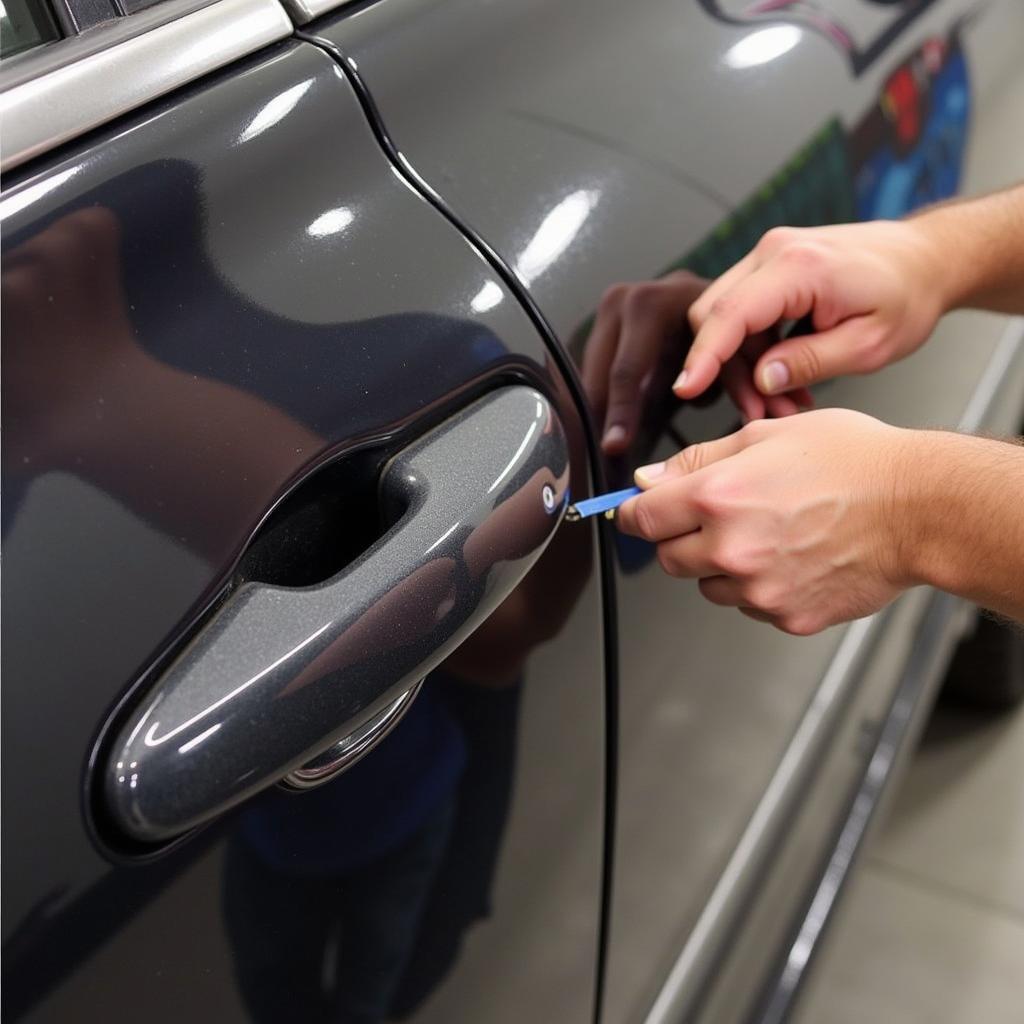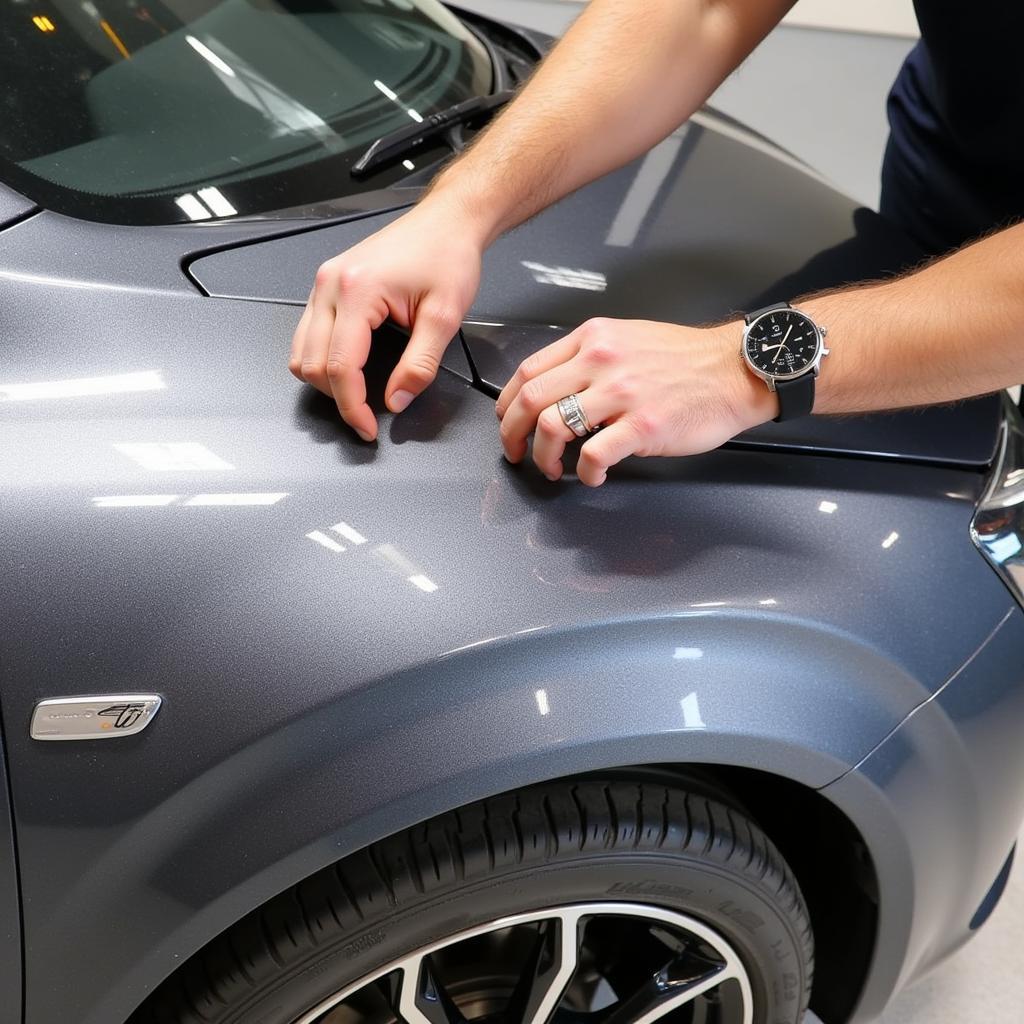Car wraps are a fantastic way to transform your vehicle’s appearance, offering a wide range of colors and finishes. But how much detail can a car wrap actually follow? The ability of a car wrap to conform to the contours of your car is a key factor in achieving a seamless, professional look. Let’s explore the intricacies of car wrap detailing and discover the limits of this versatile vehicle customization technique.
A car wrap, unlike a simple paint job, is a thin, vinyl film applied to the painted surfaces of a vehicle. Its conformability allows it to adhere to complex curves, recesses, and even some intricate details. However, the extent to which it can “follow” these details depends on several factors, including the quality of the vinyl, the skill of the installer, and the complexity of the car’s surface. Want to learn more about achieving a professional-looking detail? Check out how to properly debadge a car for detailing.
Factors Influencing Car Wrap Detail
Several key elements determine how effectively a car wrap can conform to intricate details:
- Vinyl Quality: Higher quality vinyl films are generally more pliable and stretchable, allowing for better adhesion to complex shapes. Cheaper vinyls may be less flexible and prone to wrinkles or air bubbles, especially in detailed areas.
- Installer Skill: The expertise of the installer is paramount. A skilled installer can manipulate the vinyl to conform to even the most challenging curves and recesses, ensuring a smooth, paint-like finish. Improper installation can lead to visible seams, lifting, and a generally unprofessional look.
- Surface Complexity: The shape of the car itself plays a significant role. Vehicles with sharp angles, deep recesses, or highly textured surfaces can be more challenging to wrap, requiring more skill and potentially compromising the level of detail achievable.
- Design Complexity: Intricate designs with fine lines or small text elements can be difficult to reproduce accurately with a car wrap, especially in areas with complex curves.
After a fresh wrap, you’ll want to keep it clean. Learn more about what detail car wash primer does Toyota use.
Can a Car Wrap Follow Every Detail?
While car wraps are incredibly versatile, they do have limitations. Extremely small details, deep crevices, and sharp, inward-facing angles can pose challenges. For example, the tight gaps around door handles or the intricate grilles on some vehicles may require additional trimming and meticulous work to achieve a seamless finish.
 Car Wrap Detailing Around Door Handle
Car Wrap Detailing Around Door Handle
How to Maximize Car Wrap Detail
To achieve the highest level of detail with a car wrap:
- Choose High-Quality Vinyl: Opt for premium cast vinyl films designed specifically for vehicle wrapping.
- Hire a Skilled Installer: Research and select an experienced installer with a proven track record of high-quality work. Ask for examples of their previous projects, especially those involving complex details.
- Prepare the Surface Properly: Thorough cleaning and decontamination of the vehicle’s surface are crucial for proper adhesion and a smooth finish. This includes removing any wax, sealant, or other contaminants that could interfere with the vinyl’s bond.
Thinking of detailing your car yourself? Check out how to do a full car detail.
Common Misconceptions About Car Wrap Detailing
Some believe a car wrap can perfectly replicate every intricate detail of a car’s surface. While it can conform to a surprising degree, there are limits. Deep, narrow grooves or extremely intricate textures may not be fully covered, requiring careful planning and execution by the installer.
 Car Wrap Application on a Textured Surface
Car Wrap Application on a Textured Surface
“A common misconception is that a wrap is a miracle solution for every surface,” says John Smith, Lead Installer at Wrap It Up UK. “While we can achieve incredible results, it’s crucial to manage expectations and understand the limitations of the material.”
Does Car Wrap Thickness Affect Detailing?
The thickness of the vinyl can influence its ability to conform to intricate details. Thicker films are generally more durable but less pliable, potentially limiting their ability to adhere to complex shapes. Thinner films offer greater flexibility but may be more susceptible to damage. The optimal thickness depends on the specific application and the complexity of the vehicle’s surface.
“Choosing the right vinyl thickness is a crucial part of the process,” explains Jane Doe, Senior Detailer at Pristine Auto Detailing. “We consider the car’s shape and the desired finish when selecting the appropriate material.”
Conclusion
Car wraps can follow a remarkable amount of detail, transforming the look of your vehicle with stunning results. However, understanding the limitations and factors influencing their conformability is key to achieving a professional and seamless finish. By choosing high-quality vinyl, hiring a skilled installer, and understanding the complexities of the process, you can maximize the detail your car wrap can follow and achieve the desired aesthetic. If you’re looking to improve your detailing skills and earn more, take a look at how to make more money detailing cars.
FAQ
- Can a car wrap cover deep scratches? Minor scratches may be concealed, but deep scratches may still be visible through the wrap.
- How long does a car wrap last? With proper care, a car wrap can last for several years.
- Is it easy to remove a car wrap? Professional removal is recommended to avoid damage to the underlying paint.
- Can I wash my wrapped car? Yes, hand washing is recommended using gentle soaps and techniques.
- Can a car wrap be applied to any car? Most cars can be wrapped, but some surfaces may present challenges.
- What are the different finishes available for car wraps? Gloss, matte, satin, chrome, and various textured finishes are available.
- How much does a car wrap cost? The cost varies depending on the size of the vehicle, the complexity of the design, and the quality of the vinyl.
Common Scenarios
- Wrapping around emblems: While possible, it’s often recommended to remove emblems for a cleaner look.
- Wrapping intricate grilles: This requires a skilled installer and may involve some trimming for a seamless finish.
- Wrapping door handles: Proper technique is essential to avoid lifting and ensure a durable finish.
Related Resources
Explore more about car interior detailing yourself.
Need Help?
For any assistance or further inquiries, contact us via WhatsApp: +1(641)206-8880 or Email: [email protected]. Our customer service team is available 24/7.

Leave a Reply